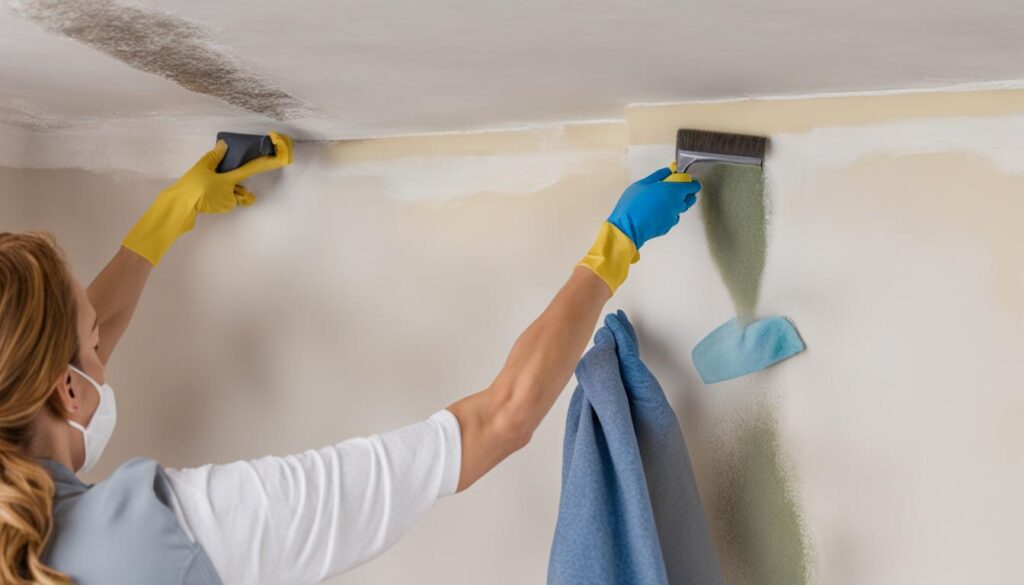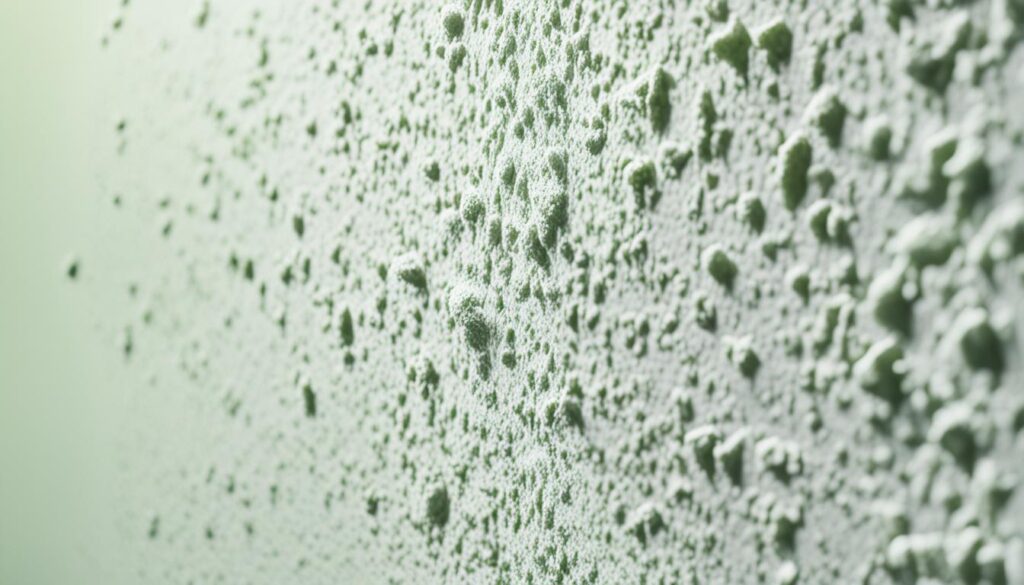
Mold Remediation: Fix Mold on Sheetrock Easily
Mold growth on sheetrock can be a serious problem, affecting both the appearance and the structural integrity of your walls. If not addressed promptly, mold on sheetrock can also pose health risks to you and your family. In this section, we will provide you with valuable insights on how to fix mold on sheetrock, offering step-by-step instructions and tips for effective mold removal. Whether you are dealing with small patches or extensive mold growth, our guide will help you tackle the issue and restore the condition of your sheetrock surfaces.
Key Takeaways:
- Fixing mold on sheetrock requires effective techniques for mold removal.
- Follow our step-by-step guide for DIY sheetrock mold removal.
- Prevent mold on sheetrock by implementing proper moisture control measures.
- Maintain good ventilation and humidity levels to minimize mold growth.
- Contact professional mold remediators for expert assistance if needed.
DIY Sheetrock Mold Removal: Step-by-Step Guide
If you’ve discovered mold on your sheetrock walls, it’s essential to take immediate action to prevent further damage and protect your health. With our comprehensive step-by-step guide, you can effectively remove mold from your walls and ensure a safe living environment.
Gather the Necessary Supplies
Before you begin the mold removal process, gather these supplies:
- Protective gear: gloves, safety goggles, and a respirator mask
- Mold cleaner: choose a commercial mold remover or create a DIY solution with equal parts water and vinegar or bleach
- Scrub brush or sponge
- Plastic sheets or tarps
- Painter’s tape
- Drywall patching compound
- Sanding sponge or sandpaper
- Paint and primer
Ensure Safety Precautions
Prior to starting the mold removal process, protect yourself by following these safety precautions:
- Wear protective gear, including gloves, safety goggles, and a respirator mask, to prevent exposure to mold spores and cleaning chemicals.
- Seal off the work area with plastic sheets or tarps, using painter’s tape to secure them in place. This will prevent mold spores from spreading to other areas of your home.
Effective Techniques for Mold Removal
Follow these steps to safely and efficiently remove mold from your sheetrock walls:
- Identify the extent of the mold growth. If the affected area is larger than 10 square feet, it is recommended to seek professional assistance.
- Wet the affected area with water to minimize the release of mold spores during the cleaning process.
- Apply the mold cleaner to the mold-infested sheetrock using a scrub brush or sponge. Scrub gently in circular motions to remove the mold from the surface.
- Rinse the cleaned area with water and allow it to dry completely.
- Inspect the sheetrock for any remaining mold stains. If stains persist, repeat the cleaning process.
- If the sheetrock has been significantly damaged by mold, remove and replace the affected section. Use a drywall patching compound to repair any holes or cracks.
- After the sheetrock is completely dry, sand the repaired area using a sanding sponge or sandpaper to create a smooth surface.
- Apply a coat of primer to the repaired section to prepare it for painting.
- Finish the process by applying paint to the entire wall, ensuring a uniform and aesthetically pleasing finish.
Prevent Future Mold Growth
To minimize the risk of mold growth on your sheetrock walls in the future, consider implementing these preventive measures:
- Fix any water leaks or plumbing issues to reduce moisture levels.
- Ensure proper ventilation in high-humidity areas, such as bathrooms and kitchens.
- Maintain the humidity levels in your home between 30-50%.
- Regularly inspect and clean your gutters to prevent water buildup near your walls.
- Monitor indoor humidity levels with a hygrometer and use dehumidifiers if necessary.
By following this step-by-step guide and implementing preventive measures, you can effectively remove mold from your sheetrock walls and prevent future mold growth. Remember, if you’re dealing with extensive mold growth or have underlying structural issues, it’s advisable to seek professional mold remediation services.

Note: The image above is for illustrative purposes only and does not represent an exact depiction of sheetrock mold removal process.
Preventing Mold on Sheetrock: Tips and Best Practices
In this section, we will provide valuable tips and best practices specifically tailored to preventing mold on sheetrock surfaces. By implementing these preventive measures, you can significantly reduce the chances of mold growth and ensure a healthier environment for you and your family.
Minimize Moisture
- Repair any leaks or plumbing issues promptly to prevent water damage.
- Ensure proper ventilation in bathrooms, kitchens, and other high-moisture areas by using exhaust fans or opening windows.
- Use a dehumidifier to maintain optimal humidity levels, ideally between 30% and 50%.
Improve Ventilation
- Keep air vents and ducts clean and unobstructed to promote better air circulation.
- Regularly open windows and doors to allow fresh air to circulate throughout your home.
- Consider installing ceiling fans to enhance airflow in rooms with poor ventilation.
Maintain Proper Humidity Levels
- Monitor humidity levels using a hygrometer and make necessary adjustments to keep them within the recommended range.
- Avoid overwatering houseplants, as excessive moisture can contribute to mold growth.
- Use a moisture barrier, such as plastic sheeting, when installing sheetrock in high-moisture areas like basements or bathrooms.
Remember, prevention is key when it comes to mold on sheetrock. By implementing these tips and best practices, you can protect your sheetrock surfaces and maintain a mold-free home environment.

Implementing these mold prevention strategies will help you maintain the integrity of your sheetrock surfaces and ensure a healthier living space. By minimizing moisture, improving ventilation, and maintaining proper humidity levels, you can significantly reduce the risk of mold growth on your sheetrock walls. Stay proactive in mold prevention to create a safe and mold-free environment for you and your loved ones.
Conclusion
In conclusion, addressing mold issues on sheetrock can be achieved effectively by following proper mold removal techniques and implementing preventive measures. Our step-by-step guide provides detailed instructions to remove mold from sheetrock surfaces, guiding you through the process efficiently and safely. By taking proactive measures to prevent mold growth, such as minimizing moisture, improving ventilation, and maintaining appropriate humidity levels, you can safeguard your sheetrock walls from future mold infestations.
By following these guidelines, you can ensure a healthier environment for you and your family, free from the dangers and discomforts associated with mold. However, if you require professional assistance with mold assessment and remediation in Florida, Fix Mold Miami is here to help. You can rely on our team of experts to provide expert services and tailored solutions to address your specific mold issues. Contact Fix Mold Miami at 305-465-6653 to schedule a consultation or learn more about our comprehensive mold remediation services.
Don’t let mold compromise your sheetrock walls and indoor air quality any longer. Trust in our expertise and take the necessary steps to eliminate mold and prevent its return. Your health and wellbeing deserve a mold-free environment, and with our guidance and professional assistance, you can achieve it.




